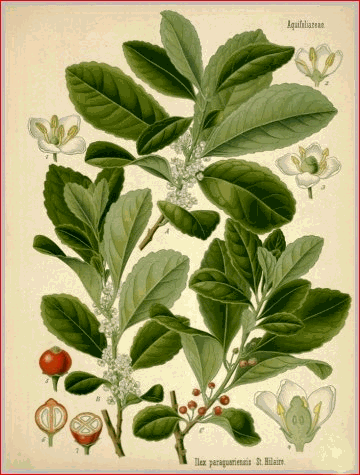
 Mat�.
Ilex paraguayensis St. Hil.
Mat�.
Ilex paraguayensis St. Hil.
Compiled by Ivor Hughes.
Ilex paraguayensis St. Hil. ( I. Mat� St. Hilaire) yields the celebrated Paraguay tea, or Mat�, so extensively consumed as a beverage in the interior of South America. It is a small tree or shrub growing wild along streams in Paraguay, Brazil and other South American countries, and also cultivated for the sake of its leaves, which are the part used.
They vary in outline from obovate, obovate-oblong to elliptic-oblong, possess an obtuse or obtusely acuminate apex, tapering base and crenate-serrate margin and are short-petioled.
These are stripped from each plant every two or three years. The period of their collection extends from December to August, sometimes beginning earlier but never continuing later. Companies are formed who penetrate far into the forest at a distance from the settlements, and devote a long time to the collection and preparation of the leaves.
These are first dried by exposure to heat, and are then reduced to powder more or less fine, which is kept for several months protected from moisture, and then packed in sacks and delivered to commerce. (See Ph. Rec., 1891.)
They have a balsamic odor and bitter taste, and are usually at first disagreeable to the palate. They have a pleasant and corroborant effect upon the stomach, but, when largely taken, cause purging and vomiting. They are used in the form of infusion, which is prepared from the entire leaves as we prepare tea; or, under the name of cha mat�, a fine powder is put in a cup of hot water by the drinker, and after a moment's stirring, the fluid is sucked up by means of a tube expanded below, and pierced with fine holes, so as to strain out the powder.
They contain, besides other substances, a peculiar tannin and the alkaloid caffeine in variable amount. Some fresh leaves of Ilex paraguayensis grown in the Cambridge Botanical Gardens were found by A. H. Alien, after drying, to contain 15.6 per cent, of tannin and 1.13 per cent, of caffeine. (Com. Org. Anal., 2d ed., iii, Part II, 527.) The consumption of mate, or yerba, in South America is enormous. Although largely produced in the Argentine Republic, tons are annually shipped to countries in South America.
If you did not find what you were seeking, use the search box at the top right hand of the page or else peruse the main library.
![]()